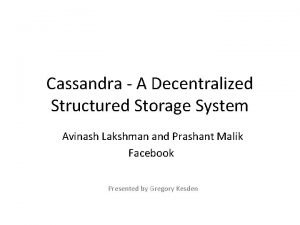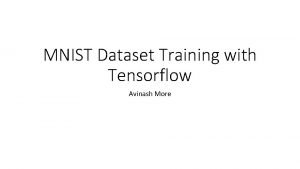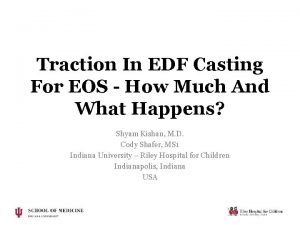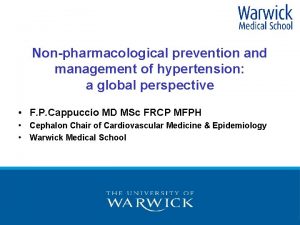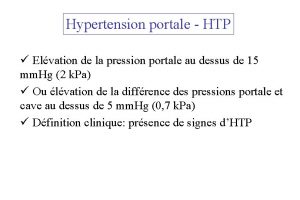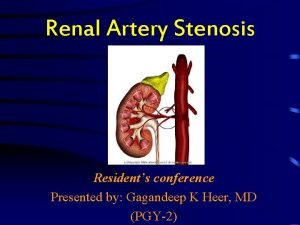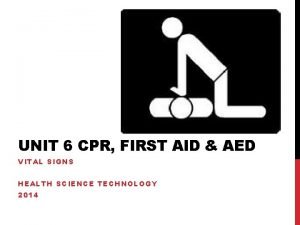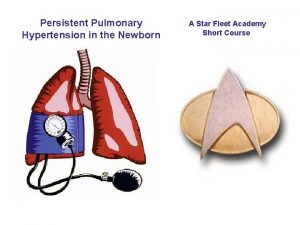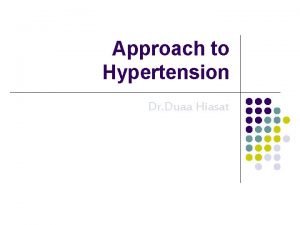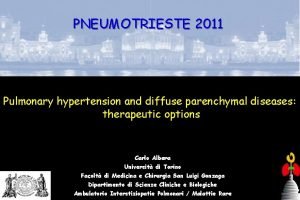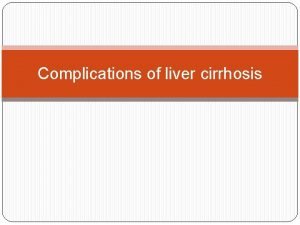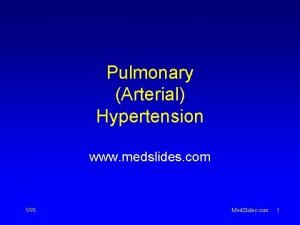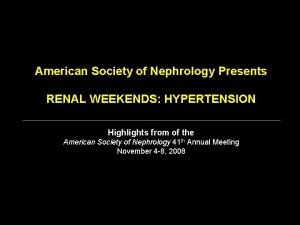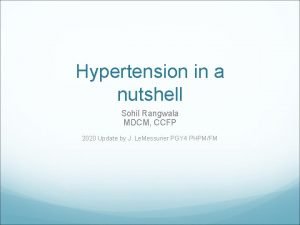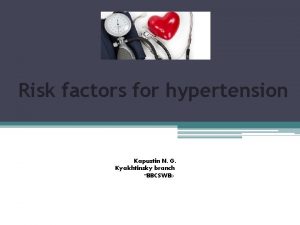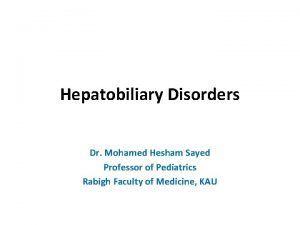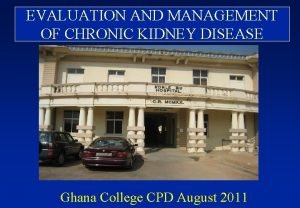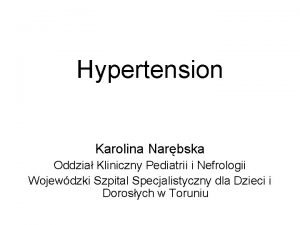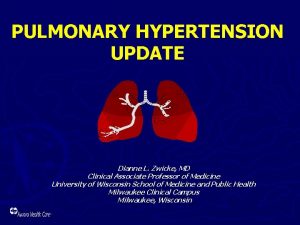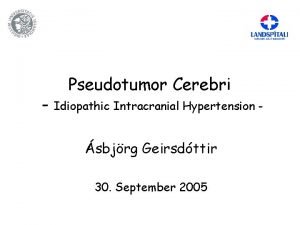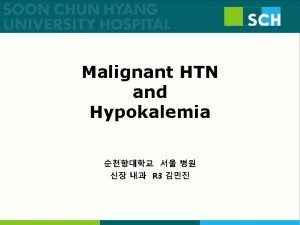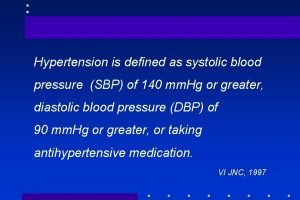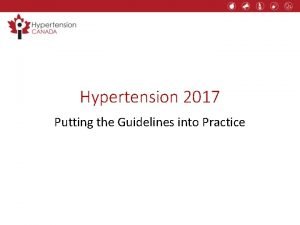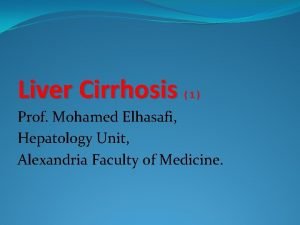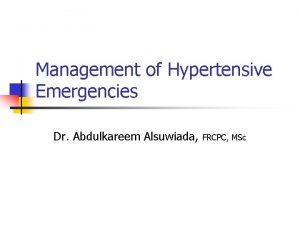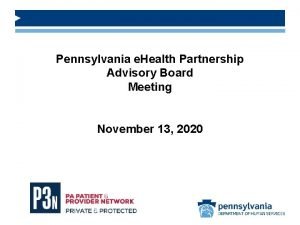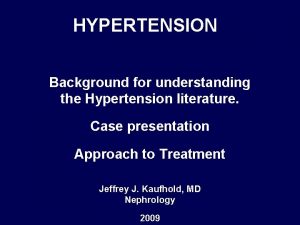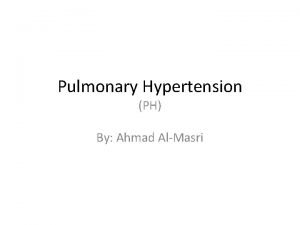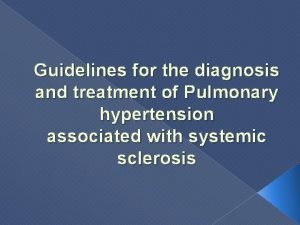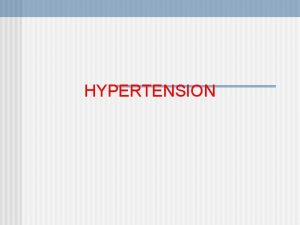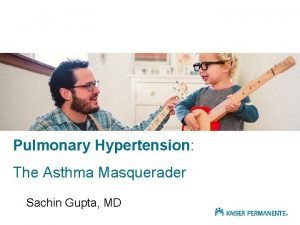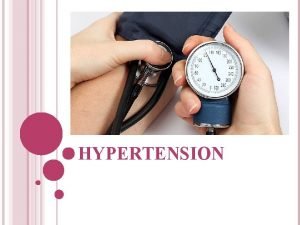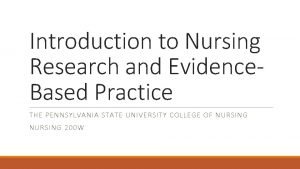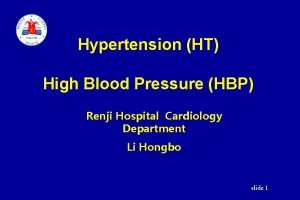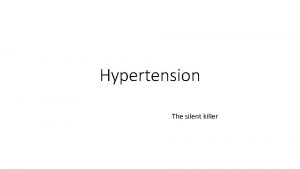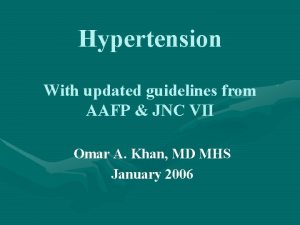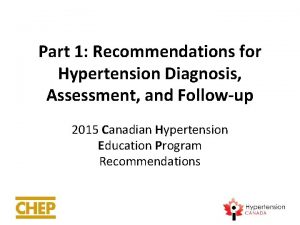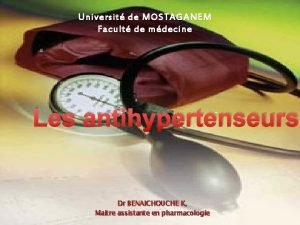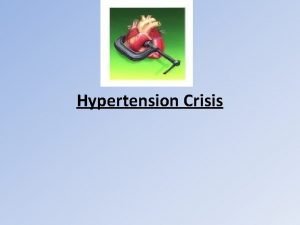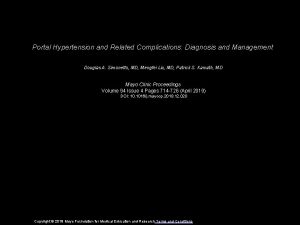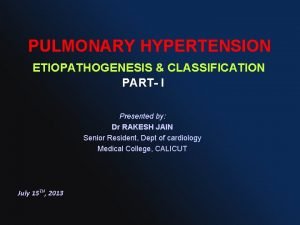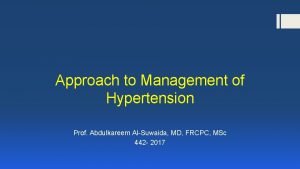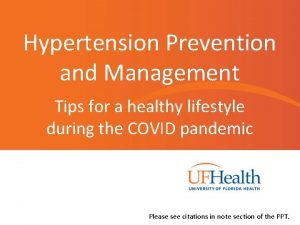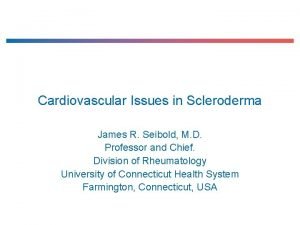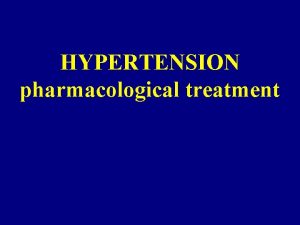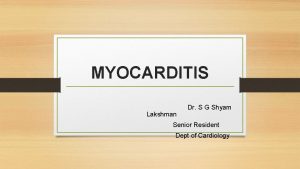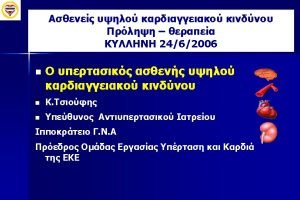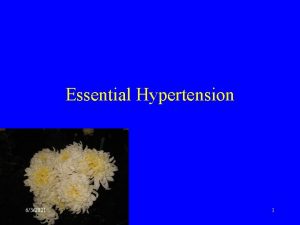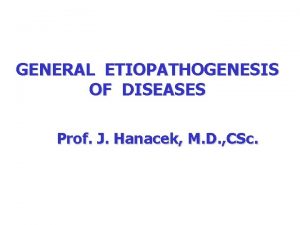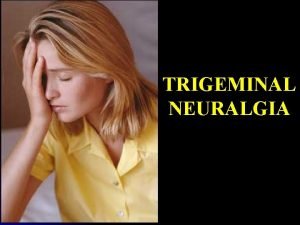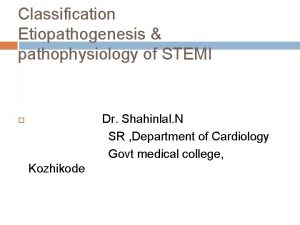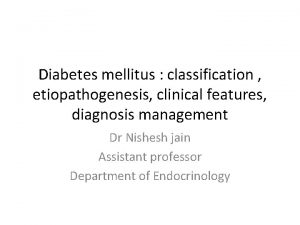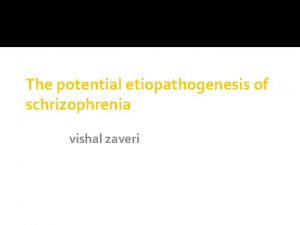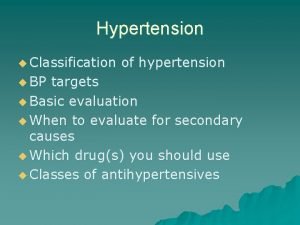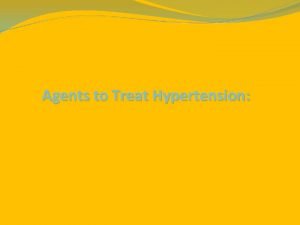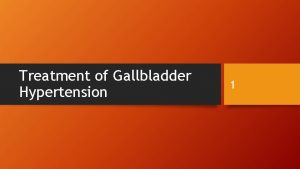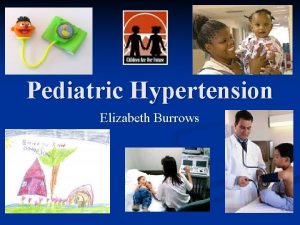HYPERTENSION ETIOPATHOGENESIS Dr S G SHYAM LAKSHMAN SR




































































- Slides: 68

HYPERTENSION ETIOPATHOGENESIS Dr S G SHYAM LAKSHMAN SR CARDIO Ist YR

INTRODUCTION �Hypertension remains the most common, readily identifiable, and reversible risk factor for myocardial infarction (MI), stroke, heart failure, atrial fibrillation, aortic dissection, and peripheral arterial disease. �The prevalence of hypertension is increasing rapidly in developing countries, where poor hypertension treatment and control contribute to the growing epidemic of cardiovascular disease

�The asymptomatic nature of this condition delays diagnosis. Effective treatment requires continuity of care by a knowledgeable clinician and frequent medical check ups, which are less common in men and in members of low-income minority groups. �Treatment therefore remains empirical, often requiring three or more pharmacologic agents with complementary mechanisms of action along with lipidlowering drugs, antiplatelet drugs, and drugs for concomitant medical conditions such as diabetes

�More than 40% of non-Hispanic black adults in the United States have hypertension, compared with 25% of non-Hispanic white and Hispanic adults �Overall prevalence for hypertension in India was 29. 8%(raghupathy et al)1. �The awareness levels for HTN in rural parts of India ranged from a low of 12% in Car Nicobar islands to a high of 43% in Kerala 2. Awareness was above 20% in almost all rural studies except one study 3.

BEHAVIOURAL DETERMINANTS �Smoking increases BP by 10 to 20 mm hg. �Heavy drinking. �Excessive consumption of calories and hypertension. GENETIC DETERMINANTS � 20 genes. �genome-wide association studies confirmed eight loci for blood pressure, but the individual effect size for each is so small that together these loci explain less than 1% of blood pressure variance.

DEFINITION The following definitions were suggested by JNC 7 and are based upon the average of two or more properly measured readings at each of two or more office visits after an initial screening �Normal blood pressure: systolic <120 mm. Hg and diastolic <80 mm. Hg �Prehypertension: systolic 120 to 139 mm. Hg or diastolic 80 to 89 mm. Hg. �Stage 1: systolic 140 to 159 mm. Hg or diastolic 90 to 99 mm. Hg

�Although definitions of hypertension and prehypertension were not specifically addressed in the 2014 JNC 8, thresholds were adopted for the treatment of blood pressure that are generally consistent with these definitions. �Isolated systolic hypertension is considered to be present when the blood pressure is ≥ 140/<90 mm. Hg. �isolated diastolic hypertension is considered to be present when the blood pressure is <140/≥ 90 mm. Hg. �Patients with blood pressure ≥ 140/≥ 90 mm. Hg are considered to have mixed systolic/diastolic hypertension.

Isolated Systolic Hypertension in Older Adults �After the age of 55 years, ISH (systolic blood pressure > 140 mm Hg and diastolic blood pressure < 90 mm Hg) predominates. �In developed countries, systolic pressure rises steadily with age; by contrast, diastolic pressure rises until approximately 55 years of age and then falls progressively thereafter. �The resultant widening of pulse pressure indicates stiffening of the central aorta and a more rapid return of reflected pulse waves from the periphery, augmenting systolic aortic pressure

Cardiac Output and Tissue Blood Flow Regulation �Cardiac output = Stroke volume x Heart rate. �cardiac output is determined not only by the function of the heart but also by the peripheral circulation �Removing one kidney decreases venous return to the heart by approximately 10%. �when the heart is severely weakened and unable to adequately pump the venous return, cardiac output (total tissue blood flow) is determined mainly by the metabolic needs and other special needs of the tissues and organs of the body.


�Local blood flow regulation, as is true for most physiologic control systems, involves short- and longterm mechanisms. �Acute control occurs within seconds or minutes as a result of constriction or dilatation of the vasculature. �Myogenic response, also alter vascular resistance in response to changes in blood pressure and help to auto regulate blood flow in the different tissues. �Long-term blood flow regulation -thickening of vessel walls and decreased numbers of capillaries (rarefaction) in some tissues, additional blood vessels are generated (angiogenesis or vasculogenesis).

Blood Flow Regulation in Normotensive and Hypertensive Subjects �Tissue blood flows are approximately the same in normotensive and hypertensive subjects and are regulated at a level that is adequate to supply the needs of the tissues. �Elevated peripheral resistance-auto regulatory response that helps to maintain normal tissue blood flow despite the increased blood pressure rather than a primary cause of the hypertension. �Hemodynamic pattern – non obese subjects is normal

Mechanisms of Primary (Essential) Hypertension �The key hemodynamic abnormalities are increased cardiac output and a stiff aorta, both presumably reflecting an overactive sympathetic nervous system. �Hypertension diagnosed in middle age (typically, 30 to 50 years of age) usually has the elevated diastolic pressure pattern, with normal systolic pressure (isolated diastolic hypertension) or elevated systolic pressure (combined systolic-diastolic hypertension). �This pattern constitutes classic “essential hypertension.

�Increased coronary, renal blood flow. �Decreased splanchnic blood flow. �Normal coronary flow. �Skeletal muscle- reduced blood flow "reserve" in hypertension is probably a result of structural limitations imposed by blood vessel hypertrophy and of endothelial dysfunction due to impaired release of nitric oxide (NO). �In obese hypertensive patients, resting skeletal muscle blood flow per gram of tissue weight may be somewhat elevated compared with lean individuals.





Feedback Control Systems for Blood Pressure �Neural mechanisms. �Renal mechanisms. �Vascular mechanisms. �Obesity and metabolic syndrome related hypertension.


The Renal–Body Fluid Feedback Mechanism for Long-Term Blood Pressure Regulation �A key mechanism for regulating salt and water balance is pressure natriuresis and diuresis, the effect of increased blood pressure to raise sodium and water excretion. �As long as fluid excretion exceeds fluid intake, extracellular fluid volume will continue to decrease, reducing venous return and cardiac output until blood pressure returns to normal and fluid balance is reestablished. �Various hormonal and neural control systems can amplify or blunt the basic effects of blood pressure on sodium and water excretion like Ang II and aldosterone.

Neurohumoral Mechanisms of Hypertension � The Sympathetic Nervous System � Baroreceptor Reflexes in Hypertension. � Obesity

�In hypertension, the baroreceptors reset to defend a higher level of blood pressure. �Baro reflex control of sinus node function is abnormal even in mild hypertension, but baro reflex control of systemic vascular resistance and blood pressure is well preserved until diastolic function is impaired. �Partial baroreceptor dysfunction is common in elderly hypertensive patients – orthostatic hypotension, supine hypertension, and symptomatic postprandial hypotension �Rheos system- RHEOS trial There were no group differences at 6 or 12 months in the co primary endpoints of percentage of subjects in whom systolic blood pressure decreased by at least 10 mm Hg

�Renal sympathetic nerves cause renal vasoconstriction and vascular hypertrophy via alpha-1 receptors. �Stimulate renin release via beta-1 receptors. �Enhance renal sodium and water reabsorption via alpha- 1 receptors. �Catheter based renal denervation. �SIMPLICITY –I, 2, 3 trials.

The Sympathetic Nervous System �Changes in SNS activity, caused by various reflex mechanisms, CNS ischemia, or by activation of higher centers in the brain, provide powerful and rapid, moment-to-moment regulation of blood pressure. �Activation of the renal sympathetic nerves. �Increased renin secretion, and impaired renal pressure natriuresis �Increased heart rate and cardiac output, plasma and urinary norepinephrine levels. regional norepinephrine spill over.

� peripheral postganglionic sympathetic nerve firing (determined by microelectrode Recordings). �Alpha-adrenergic receptor–mediated vasoconstrictor tone in the peripheral circulation.

Role of Baroreceptor Reflexes in Hypertension �Helps in buffering moment-to-moment changes in blood pressure. �Powerful means for moment-to-moment regulation of arterial pressure. �With prolonged increases in arterial pressure, the baro reflexes may contribute to reductions in renal sympathetic activity and promote sodium and water excretion. �Impairment of baro reflexes may cause increased lability of blood pressure in hypertension and may fail to attenuate the increase in blood pressure

�Acute physiologic stresses, including pain, exercise, exposure to cold, and mental stress, can all lead to increased SNS activity and transient hypertension. Obesity related hypertension �With weight gain, reflex sympathetic activation may be an important. �compensation to burn fat, but at the expense of sympathetic over activity in target tissues (i. e. , vascular smooth muscle and kidney) that produces hypertension.

�Fructose ingestion acutely causes more of a ‘white coat’ type of hypertension , it also causes microvascular disease and tubulo interstitial inflammation. �Fructose entry into cells is followed by unregulated phosphorylation by the enzyme fructo kinase, resulting in rapid adenosine triphosphate depletion, cell ischemia, and uric acid generation. �Chronic elevations in uric acid can inhibit endothelial function, activate the renin–angiotensin system, and cause blood pressure elevation in animals.

�Fructose entry into cells is followed by unregulated phosphorylation by the enzyme fructo kinase, resulting in rapid adenosine triphosphate depletion, cell ischemia, and uric acid generation. �chronic elevations in uric acid can inhibit endothelial function, activate the renin–angiotensin system, and cause blood pressure elevation in animals





Obstructive sleep apnoea �With repeated arterial desaturation during apnoea, activation of carotid body chemoreceptors causes dramatic pressor episodes throughout the night and resets the chemoreceptor reflex; daytime normoxia is misinterpreted as hypoxia, producing sustained reflex sympathetic activation and hypertension even during waking hours. Renal mechanisms �Fundamental abnormality is an acquired or inherited defect in the kidneys’ ability to excrete the excessive sodium load imposed by a modern diet high in salt.

�Renal sodium retention expands the plasma volume, increasing cardiac output and triggering auto regulatory responses that increase systemic vascular resistance. �In normotensive persons, blood pressure elevation invokes an immediate increase in renal sodium excretion to shrink plasma volume and to return blood pressure to normal. �Resetting of the pressure-natriures is curve prevents the return of blood pressure to normal, so that fluid balance is maintained but at the expense of high blood pressure. �It also leads to nocturia, one of the most common and bothersome symptoms in patients with uncontrolled hypertension.

Generalized Increases in Preglomerular Resistance �Suprarenal aortic coarctation or constriction of one of the renal arteries and removal of the contralateral kidney �Immediately after constriction of the renal artery or aortic coarctation, renal blood flow is reduced, and there is a rapid increase in renin secretion and transient sodium retention. �Diffuse renal arteriolar sclerosis, particularly in preglomerular vessels. � Presumably, functional or pathologic increases in preglomerular resistance at other sites besides the main renal arteries, such as the interlobular arteries or afferent

Patchy Increases in Preglomerular Resistance �With prolonged hypertension, pathologic changes in the untouched kidney add to the impairment of overall renal excretory capability. �At this stage, removal of the clipped kidney only partially restores arterial pressure to normal. However, removal of the contralateral untouched kidney and unclipping the stenotic kidney normalizes blood pressure. �Thus, chronic exposure to high blood pressure in the untouched kidney causes structural changes as well as functional changes that contribute to the progression of hypertension in this model

Decreased Glomerular Capillary Filtration Coefficient �Reducing the glomerular capillary filtration coefficient (Kef) initially lowers GFR and sodium excretion while stimulating renin release and causing vase dilation of afferent arterioles via a macula dense feedback. �Increases in blood pressure and glomerular hydrostatic pressure, which offset a decrease in Kf and restore sodium excretion to normal, may also lead to additional renal dysfunction over a period of years by causing further glomerular injury leading to hypertension.

Reduced Nephron Number Increases Salt Sensitivity of Blood Pressure � Loss of functional nephrons because of ischemia or infarction of renal tissue usually causes marked hypertension that is initially caused by increased renin secretion. �Nephron loss may also initiate compensatory changes that damage the surviving nephrons like renal vasodilation and increased single-nephron GFR may lead to glomerulo sclerosis and reductions in Kef which impairs pressure natriuresis sufficiently to cause severe hypertension

Increased Renal Tubular Sodium Reabsorption �Increased Distal and Collecting Tubule Reabsorption Causes Salt-Sensitive Hypertension. �Decreased renin levels. �Increased aldosterone level. Increased Proximal Reabsorption �Salt insensitive hypertension. �Increased tubular reabsorption before the macula densa tends to increase renin secretion and elicits a compensatory renal vasodilation that raises GFR and renal plasma flow

RAAS �Two main angiotensin receptor types (AT) are known. �AT 1 receptors are widely expressed in the vasculature, kidneys, adrenals, heart, liver, and brain. �Enhanced AT 1 -mediated signalling provides a central mechanistic explanation for the frequent coexistence of elevated blood pressure with insulin resistance. �AT 2 receptor activation opposes some of the deleterious effects of AT 1 receptors by promoting endotheliumdependent vasodilation by bradykinin and nitric oxide pathways.

Aldosterone �Pressure natriuresis and blood pressure regulation. �Sites of sodium reabsorption are the principal cells of the distal tubules, cortical collecting tubules, and collecting ducts. � Activates sodium current in principal cells of the cortical collecting tubule through activation of the amiloridesensitive channel. �With low sodium intake, increased aldosterone helps prevent sodium loss and reductions in blood pressure. �In obese, insulin-resistant patients, there may be enhanced sensitivity to the effects of aldosterone

The Endothelin System � 203 -amino-acid peptide precursor, preproendothelin, which is cleaved after translation to form proendothelin. �ET-1 receptor binding sites -greatest numbers of receptors in the kidneys and lungs. �ET-1 produces vasoconstriction, impairs renal pressure natriuresis, and increases blood pressure via ETA. �ET-1 decreases GFR and renal plasma flow through stimulation of vascular smooth muscle and mesangial cell contraction

�ETB activation causes vasodilation, enhances renal pressure natriuresis, and decreases blood pressure. �Both intrarenal and extrarenal mechanisms could theoretically mediate the hypertension produced by chronic disruption of ETB receptors.

Nitric Oxide �Can be divided into hemodynamic and tubular components. �Decrease renal sodium excretory function by increasing renal vascular resistance. �Increase renal tubular sodium reabsorption. �Enhancing the renal vascular responsiveness to vasoconstrictors such as Ang II or norepinephrine. � reduces renal interstitial fluid hydrostatic pressure (RIHP) and urinary sodium excretion

Vascular Mechanisms �Dysfunctional endothelium displays impaired release of endothelium-derived relaxing factors. �Smoldering vascular inflammation contributes to the genesis and complications of high blood pressure Creactive protein, an easily measured serum biomarker, “reports” on inflammation. �Oxidative stress also contributes to endothelial cell vasodilator dysfunction in hypertension.

�Superoxide. �xanthine oxidase. VASCULAR REMODELLING �Increase in the medial thickness relative to the lumen diameter (increased media-to-lumen ratio). �Media-to-lumen ratio increases, but the medial cross- sectional area remains unchanged. �Large-artery remodelling is characterized by the expression of hypertrophic genes, triggering increases in medial thickness and in the media-to-lumen ratio

IMMUNE MECHANISMS �Persisting, low-grade inflammation in these target organs may lead to impaired pressure natriuresis, an increase in sympathetic activity, and vascular endothelial dysfunction that may be the cause of chronic elevation of blood pressure in essential hypertension. �The mechanism by which the interstitial T cells contribute to hypertension has been shown to involve local angiotensin II generation and oxidant generation. �One of the key drivers of salt-sensitive hypertension appears to be the infiltrating T cells and macrophages within the renal interstitium.









PATHOGENESIS OF HYPERTENSIVE HEART DISEASE �Pressure overload hypertrophy �myocyte hypertrophy, �Medial hypertrophy of the intra myocardial coronary arteries and collagen deposition, leading to cardiac fibrosis. �Impaired Coronary Vasodilator Reserve �vasodilator reserve becomes impaired when myocyte mass outstrips the blood supply. �blunted or absent coronary vasodilator reserve, leading to sub endocardial ischemia under conditions of increased myocardial oxygen demand. �Heart failure.

Hypertensive Heart Disease �Hypertension may contribute to CAD more than is commonly realized because hypertensive persons have more silent ischemia and unrecognized MI’s. �On the electrocardiogram, LVH with strain is a serious harbinger of new-onset heart failure and heart failure death. �Hypertension also constitutes a major risk factor for, and is present in, an overwhelming majority of patients with aortic dissection (distal more than proximal dissection), abdominal aortic aneurysm, and peripheral arterial disease.

Identifiable (Secondary) Forms of Hypertension : Renal Parenchymal Disease: � 2% to 5% of cases. �Micro albuminuria of 30 to 300 mg/day relates closely to target organ damage. �Loss of filtration surface leads to both glomerular and systemic hypertension, which engenders more glomerular sclerosis, setting up a cycle of progressive disease. �Severe insult to the kidneys that markedly impairs excretion of salt and water, which leads to volume expansion, or that reduces renal blood flow. �Non steroidal anti inflammatory drugs (NSAIDs) and inhibitors of the renin-angiotensin system.

�Chronic renal diseases associate with a higher prevalence of hypertension. �With whatever drugs are chosen to treat hypertension with CKD, and particularly with ACE inhibitors and ARBs, 30% above baseline, predicts better preservation of renal function—presumably reflecting a successful reduction in intra glomerular pressure. �Patients with diabetic nephropathy show particular protection against progressive renal damage by reduction of elevated blood pressure with an ARB-based or ACE inhibitor–based regimen.

Adrenal causes of hypertension �Adrenal causes of hypertension include primary excesses of aldosterone, cortisol, and cate cholamines; more rarely, excess deoxy corticosterone is present with congenital adrenal hyperplasia. �An adrenal “incidentaloma” is found on approximately 5% of abdominal CT scans obtained for non adrenal indications- nonfunctional. �The risk of cancer is low if a non–contrast enhanced CT scan shows a tumor density of less than 10 Hounsfield units (HU), consistent with low-density lipid;

Primary Aldosteronism

�Initial screening plasma aldosterone and renin levels. �Next step is an oral salt-loading suppression test to document the autonomy of hyperaldosteronism. �If the suppression test result is abnormal, adrenal vein sampling by an experienced tertiary center is strongly recommended, to differentiate unilateral adenoma from bilateral hyperplasia and to confirm exactly which gland should be removed by laparoscopic surgery


What’s New…? ? ? �Identification of antigen(s) responsible for driving the immune response in essential hypertension. �Autoimmune reactivity to HSPs could play a role in hypertension because these molecules, which function as chaperones of nascent proteins, are very immunogenic when accessing the extracellular compartment. �HSP 70 increased in the kidney in animal models of hypertension.

� Gut microbiota is dominated to a large extent by Firmicutes and Bacteroidetes. �The Firmicutes to Bacteroidetes ratio was recently reported as increased in SHRs, angiotensin II-induced hypertensive rats and a small group of humans with essential hypertension.

� 1. Hypertension in India: a systematic review and meta-analysis of prevalence, awareness, and control of hypertension Raghupathy Anchala, a, b Nanda K. Kannuri, b Hira Pant, b Hassan Khan, a Oscar H. Franco, c Emanuele Di Angelantonio, a and Dorairaj Prabhakarand Prince MJ, Ebrahim S, Acosta D, Ferri CP, Guerra M, Huang Y, et al. � Hypertension prevalence, awareness, treatment and control among older people in Latin America, India and China: a 10/66 cross-sectional population -based survey. J Hypertens 2012; 30: 177– 187 [Pub. Med] � 3. Manimunda SP, Sugunan AP, Benegal V, Balakrishna N, Rao MV, Pesala KS. Association of hypertension with risk factors & hypertension related behaviour among the aboriginal Nicobarese tribe living in Car Nicobar Island, Indian J Med Res 2011; 133: 287– 293
 Prashant malik cassandra
Prashant malik cassandra Avinash lakshman education
Avinash lakshman education Avinash lakshman education
Avinash lakshman education Shyam sunder meaning
Shyam sunder meaning Aunty vs boy
Aunty vs boy Shyam kishan md
Shyam kishan md Hypertension
Hypertension Signe du flot genou
Signe du flot genou Hypertension urgency vs emergency
Hypertension urgency vs emergency 6 vital signs first aid
6 vital signs first aid Pratt test varicose veins
Pratt test varicose veins Amas faa medication
Amas faa medication Mitral stenosis pulmonary hypertension
Mitral stenosis pulmonary hypertension Portal hypertension symptoms
Portal hypertension symptoms Cataractectomy
Cataractectomy Antihypertensive drugs classification
Antihypertensive drugs classification Definition of hypertension
Definition of hypertension Pneumotrieste
Pneumotrieste Stages of pulmonary hypertension
Stages of pulmonary hypertension Complication of liver cirrhosis
Complication of liver cirrhosis Medslide
Medslide Conclusion of hypertension
Conclusion of hypertension Diagnosing hypertension
Diagnosing hypertension Conclusion of hypertension
Conclusion of hypertension Neonatal liver failure
Neonatal liver failure Conclusion of hypertension
Conclusion of hypertension Hypertension
Hypertension Cld chronic liver disease
Cld chronic liver disease Non pharmacological management of hypertension
Non pharmacological management of hypertension Pulmonary hypertension
Pulmonary hypertension Hypertension
Hypertension Intracranial hypertension
Intracranial hypertension Hypokalemia
Hypokalemia Esterman visual field test dvla
Esterman visual field test dvla Definition of hypertension
Definition of hypertension Malignant hypertension
Malignant hypertension Masked hypertension
Masked hypertension Presinusoidal portal hypertension
Presinusoidal portal hypertension Hypertensive emergency vs urgency
Hypertensive emergency vs urgency Health coaches for hypertension control
Health coaches for hypertension control Hypertension
Hypertension Malignant hypertension treatment
Malignant hypertension treatment Medical nutrition therapy for hypertension
Medical nutrition therapy for hypertension Pulmonary hypertension definition
Pulmonary hypertension definition Pulmonary hypertension
Pulmonary hypertension Pathophysiology of pulmonary hypertension
Pathophysiology of pulmonary hypertension Essential hypertension
Essential hypertension Hypertension vs hypotension
Hypertension vs hypotension Sachin gupta md
Sachin gupta md Isolated systolic hypertension
Isolated systolic hypertension Rules of halves in hypertension
Rules of halves in hypertension Nursing management of portal hypertension
Nursing management of portal hypertension Disease state awareness
Disease state awareness Pico question examples labor and delivery
Pico question examples labor and delivery Antihypertensive drugs
Antihypertensive drugs Conclusion of hypertension
Conclusion of hypertension Bp
Bp Definition of pulmonary hypertension
Definition of pulmonary hypertension Jnc 7 hypertension
Jnc 7 hypertension Rules of halves in hypertension
Rules of halves in hypertension Diagnosis hypertension
Diagnosis hypertension Diueritique
Diueritique Chief complaint present illness
Chief complaint present illness Hypertensive crisis classification
Hypertensive crisis classification Portal hypertension mayo clinic
Portal hypertension mayo clinic Pah groups
Pah groups Hypertensive urgency
Hypertensive urgency Jnc 8 classification of hypertension pdf
Jnc 8 classification of hypertension pdf Nt pro brain natriuretic peptide
Nt pro brain natriuretic peptide
